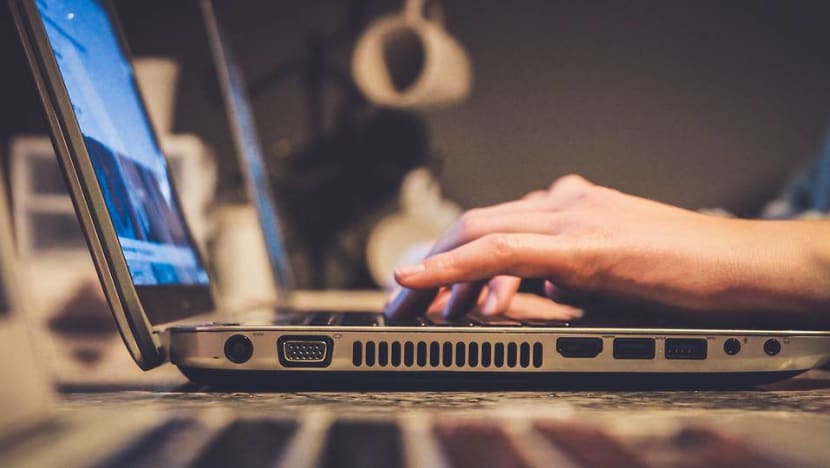commentary Commentary
Commentary: Buried under a bursting inbox? It’s time to stop our problematic email habits
Bad email habits like unnecessary exchanges and spamming recipients who need not be involved are leading to poor work outcomes, say Carys Chan.

File photo of a man looking at the computer screen. (Photo: Xabryna Kek)
SINGAPORE: It’s a situation we are all familiar with — after a relaxing weekend, we return to our email boxes to see a mountain of emails waiting, and instantly feel defeated by the “digital avalanche”.
To avoid the build-up of emails, some employees even choose to stay connected to work through their devices outside of office hours, some even while on holiday.
A 2019 study found that 80 per cent of Singaporeans surveyed checked their emails at least once during their holidays. Of these, 27 per cent did so at least once a day.
Emails are supposed to be tools to help us get things done, so it is not surprising that research has found employees spend around 2.5 hours a day reading and responding to emails.
The downside is, of the average 200 emails which employees receive each day, around 144 of them are not even relevant to the specific work they do.
It is also interesting that employees frequently bring up overtime work culture as the primary cause of job burnout.
When you dig deeper, you’ll realise that the main driver of long working hours is engaging in time-wasting tasks such as reading and responding to emails.
WHEN NOT TO USE EMAILS
Would organising a meeting or calling the person better tackle the issue you need to get resolved, instead of sending an email?
If your answer to the above question is “yes”, you shouldn’t be sending an email. Pick up the phone to organise a meeting or go to the person directly to have a conversation.

According to Statista, 293.6 billion e-mails were sent and received all across the world each day in 2019. The average adult checks their email 45 times each day, contributing to the incessant flow of emails.
These are later stored in servers within data centres, which contribute to 2 per cent of global carbon dioxide emissions annually.
Sending emails adds to the pool of emails, leading to even more emails, fuelling stress and anxiety and the need to constantly check your inbox to make sure you are on top of things.
Often, people send emails to put the ball in the other person’s court, and free themselves of the task of tackling a problem.
READ: Commentary: Digital stress - why it's time to change your relationship with your phone
READ: Commentary: When a rude boss keeps you waiting, why not get up and leave?
But the reality is, if an issue requires urgent attention, sending off an email is unlikely to be efficient. For one, it assumes the recipient is on stand-by to read and respond decisively.
Have we confused the process of sending emails with the desired outcome of getting a job completed?
WHO REALLY NEEDS TO BE COPIED?
Is there a need to hit “send all” or “reply all” to emails?
No doubt, we should all pay attention to group emails but the growing mountain of emails each of us face has forced us to prioritise some over others.
This is in part because many group emails evolve to become a needless conversation as individuals start talking directly to each other, and copying others in the same thread.
Sometimes there is knowledge management value in keeping others in the loop of the considerations that lead to an important organisational decision taken over the exchange of emails.

But over time, group emails become hard to follow and risk those involved ceasing to pay attention altogether. Others continue to “reply all” unsure if they should still include everyone or exclude anyone in the thread.
Conversations also risk going off-topic if there is little discipline, sometimes leading to no decisions or solutions, while recipients continue to receive unnecessary email notifications which distract them.
In fact, researchers use the term “email overload” to describe the use of email for functions that it was not designed for.
Such practices include sending mass emails and including everyone in follow-up responses for the sake of demonstrating responsiveness, even if recipients in the emails need not be involved in follow-ups.
THE COVERT USE OF BCC
At times, it may be a show of courtesy to include certain key decision-makers in emails, but is it always necessary to copy other people in an email?
Very often, “CC” or the covert “BCC” is used by people as a way to protect themselves from subsequent criticisms but risk confusion and tension when recipients are unsure what the intent of including them is in the first place.
READ: Commentary: Why bosses should let employees surf the web at work
READ: Commentary: All these corporate greeting cards and presents are not gifts. They're spam
Sometimes, people copy others to cover themselves, because silence is taken as complicity. But this form of shared responsibility really leads to no one taking responsibility.
Having additional recipients on the “CC” or “BCC” lists may even make accidents more likely when replies are sent to the wrong person.

EMBRACE EMAIL MINIMALISM
The caveat to the above of course depends on the organisational culture and if workers are in sync with how emails should be treated.
But there’s no denying our growing pile of emails are fuelling poor work and work-life outcomes.
Admittedly, our email culture will not change overnight, but it can begin with little steps.
As a start, allocate strict timings to check your inbox, avoiding periods when you work best. Time allocation sets boundaries on the constant need to check and respond, which also reduces the number of emails sent.
READ: Commentary: Not enough time? Transforming work and sleeping better in a digital world
If you need to send an email, decide if it is more convenient to just get up and talk to your colleague or manager, or call the person if they are based overseas.
Face-to-face and audio interactions often help to clarify issues and misunderstandings, thus minimising the need to send multiple emails.
If you are already in the middle of a long thread, keep your emails succinct and sharp. Avoid copying more people into the thread and having too many questions and discussion points in an email. This helps to ensure that the conversation remains focused.
Fundamentally, just like how employees are learning how to “switch off” outside work hours, consciously reminding ourselves to cultivate better email habits such as resisting the urge to check your email first thing in the morning and turning off notifications on your work and personal devices will assist in reducing stress and anxiety levels.
As we usher in the Year of the Rat, let’s make good email habits one of our new year goals.
Carys Chan is Assistant Professor at RMIT University's School of Management.












